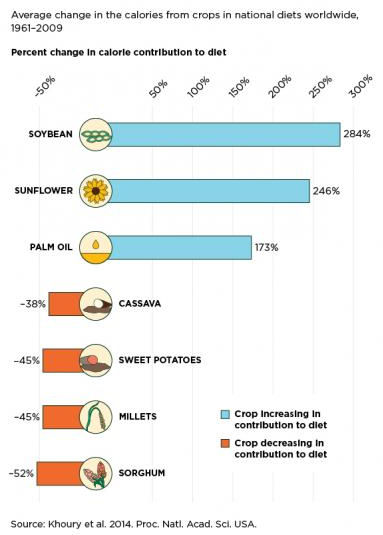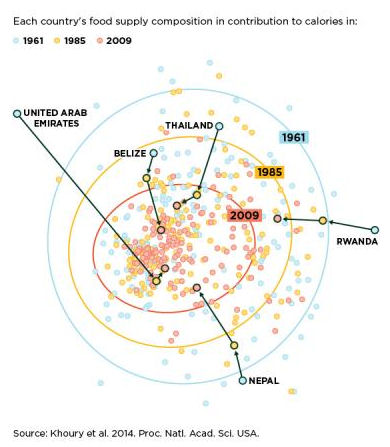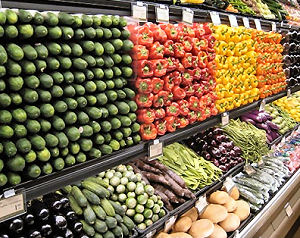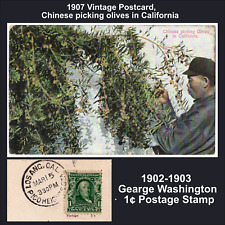
A detailed new study into global food supplies confirms for the first time what experts have long suspected: human diets around the world have grown ever more similar and the trend shows no signs of slowing, with major consequences for human nutrition and food supply reliability.
“More people are consuming more calories, protein and fat, and they rely increasingly on a short list of major food crops, like wheat, maize and soybean, along with meat and dairy products, for most of their food,” said study lead author Colin Khoury, a scientist working within the Consultative Group on International Agricultural Research (CGIAR) Consortium. “These foods are critical for combating world hunger, but relying on a global diet of such limited diversity obligates us to bolster the nutritional quality of the major crops, as consumption of other nutritious grains and vegetables declines.”
Appearing in the Proceedings of the National Academy of Sciences, the new research suggests that our growing reliance on a handful of food crops may also accelerate the worldwide rise in obesity, heart disease, and diabetes.
Khoury says that the crops now predominant in diets around the world include several that were already quite important a half-century ago – such as wheat, rice, maize and potato. But the emerging “standard global food supply” described in the study also consists of energy-dense foods that have risen to global fame more recently, like soybean, sunflower oil, and palm oil. Wheat is a major staple in 98 percent of countries and rice in 91 percent; soybean has become significant to 74 percent of countries.
In contrast, many crops of considerable regional importance – including cereals like sorghum, millets and rye, as well as root crops such as sweet potato, cassava and yam – have lost significant ground. Many other locally significant grain and vegetable crops have suffered the same fate. For example, a nutritious tuber crop known as Oca, once grown widely in the Andean highlands, has declined significantly in this region both in cultivation and consumption.

As Khoury and Guarino examined current trends in food consumption, they documented a curious paradox: as the human diet has become less diverse at the global level over the last 50 years, many countries, particularly in Africa and Asia, have actually widened their menu of major staple crops, while changing to more globalized diets.
“In East and Southeast Asia, several major foods – like wheat and potato – have gained importance alongside longstanding staples, like rice,” Khoury noted. “But this expansion of major staple foods has come at the expense of the many diverse minor foods that used to figure importantly in people’s diets.”

“Countries experiencing rapid dietary change are also quickly seeing rises in the associated diseases of overabundance,” says Khoury. “But hopeful trends are also apparent, as in Northern Europe, where evidence suggests that consumers are tending to buy more cereals and vegetables and less meat, oil and sugar.”
The researchers single out five actions that are needed to foster diversity in food production and consumption and thus improve nutrition and food security:
- Actively promote the adoption of a wider range of varieties of the major crops worldwide to boost genetic diversity and thus reduce the vulnerability of the global food system in the face of challenges that include climate change, rising food demand, and increased water and land scarcity. This action is especially important for certain crops, like banana, for which production is dominated by a very few, widely grown commercial varieties.
- Support the conservation and use of diverse plant genetic resources – including farmers’ traditional varieties and wild species related to crops – which are critical for broadening the genetic diversity of the major crops.
- Enhance the nutritional quality of the major crops on which people depend – for example, through crop breeding to improve the content of micronutrients like iron and zinc – and make supplementary vitamins and other nutrient sources more widely available.
- Promote alternative crops that can boost the resilience of farming and make human diets healthier; specifically, identifying and conserving nutritious locally grown “neglected and underutilized” crops.
- Foster public awareness of the need for healthier diets, based on better decisions about what and how much we eat as well as the forms in which we consume food.
The new study, relying on data from the Food and Agriculture Organization of the United Nations, encompassed more than 50 crops and over 150 countries (accounting for 98 percent of the world’s population) for the period 1961-2009. “International agencies have hammered away in recent years with the message that agriculture must produce more food for over 9 billion people by 2050,” said co-researcher Andy Jarvis. “Just as important is the message that we need a more diverse global food system. This is the best way, not only to combat hunger, malnutrition, and over-nutrition, but also to protect global food supplies.”
Related:
Discuss this article in our forum
Organic farming “a luxury we can’t afford,” concludes UK report
Evergreen agriculture emerges as Africa’s key to food security
Biodiversity now a public health issue
Crop pests relentless in their march polewards


















Comments are closed.